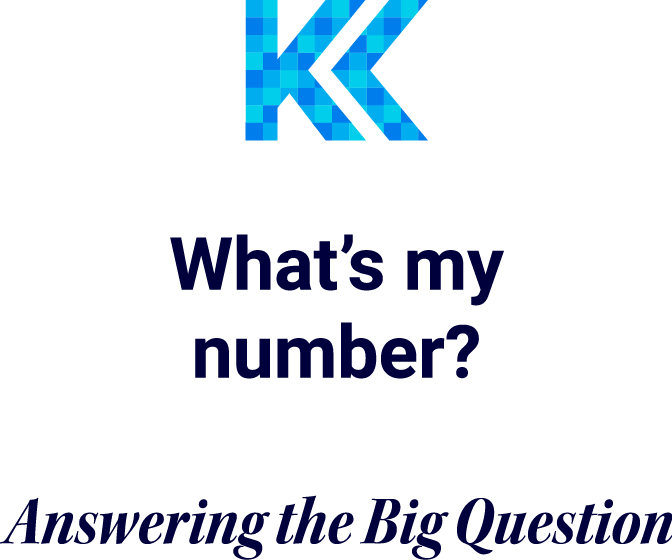There’s one question I hear more than anything else.
“Do I have enough to retire?”
It makes total sense. You’ve worked for decades, saved, paid off debt, and probably even started contemplating what retirement could look like. Maybe you’re already in retirement, yet still have a lot of uncertainty about whether you will need more income down the line. Without a clear answer from a financial advisor, the uncertainty can linger. What if the market crashes? What if you live longer than expected? What if you’re forgetting something important?
This question came up with my own parents. They had done a lot right. Still, there was that lingering feeling of “Are we sure?” That’s the feeling I try to replace with confidence, for them and every client I work with.
Here’s what I walk people through when they ask the same thing:
The Number Isn’t the Full Story
A lot of people think there’s some magic number out there. Maybe it’s a million dollars. Maybe it’s two million. But in reality, someone with $100,000 could be in great shape, while someone with $2 million could be cutting it close. It all depends on how your finances actually function in retirement.
Instead of chasing a number, we need to ask: What does your retirement life cost, and how do you plan to pay for it?
That’s the real question.
What Retirement Really Comes Down To
1. What’s coming in? (Guaranteed income)
Start by considering all the income sources you’ll have in retirement. For most people, this includes:
-
Social Security – You can claim benefits as early as age 62, but the longer you wait (up to age 70), the bigger the monthly check. Choosing when to file can make a big difference, as the optimal timing is different for everyone based on a multitude of factors. A financial advisor can help with this.
-
Pensions – If you’re lucky enough to have one, we’ll factor in how much it pays and whether it has survivor benefits.
-
Rental income, side hustle income, part-time work, etc. – Any income that keeps flowing in without touching your retirement savings helps ease the pressure.
Why this matters:
The more you can cover with guaranteed income, the less you need to draw from your savings each year. That will heavily influence your risk of running out of money too soon.
2. What’s going out? (Spending and lifestyle)
This is where we look at what retirement will actually cost. Not just today, but five, ten, and twenty years down the road.
Some things to consider:
-
Essentials: Housing, food, utilities, insurance, transportation, medical expenses.
-
Lifestyle: Travel, dining out, gifts, hobbies, golf memberships, home renovations, etc.
-
Health care: Having an HSA and Medicare helps, but it doesn’t cover everything. You’ll likely need a supplement plan and should plan for out-of-pocket costs.
-
Inflation: Your $10,000/month lifestyle today could cost $12,000/month in 10 years, even with average inflation. You probably wouldn’t want to see the numbers extended to 20 years and beyond. Inflation matters and needs to be taken into account.
A lot of people assume they’ll spend less in retirement, but that’s not always the case. You may not be commuting anymore, but you might be booking more flights or helping kids and grandkids. Some expenses shrink, others grow.
3. What fills the retirement gap? (Your savings and strategy)
This is the part most people are thinking about, but often without context.
Once you know how much income is coming in and how much is going out, the difference (your “gap”) needs to be covered by your retirement accounts: your IRAs, 401(k)s, Roth accounts, brokerage accounts, and any cash reserves.
This is where planning really matters.
-
How much can you safely withdraw each year? You’ve probably been told 4%, but it’s not one-size-fits-all.
-
Which accounts should you tap first? Order of withdrawals affects both taxes and the longevity of your savings.
-
How are your investments allocated? Too aggressive and you risk losses when you need stability. Too conservative and you might not keep up with inflation.
-
What about taxes? Strategic Roth conversions, tax-efficient withdrawals, and capital gains planning can make a big difference over a 30-year retirement.
You don’t just want to have enough. You want a system that gives you income in the most efficient way possible.
Common Retirement Myths
A few ideas come up over and over again that aren’t totally accurate.
-
“I need $1 million or I can’t retire.”
Maybe. Maybe not. It depends entirely on your lifestyle and income sources. -
“I’ll spend a lot less in retirement.”
Possibly, but not always. Travel, grandkids, and health care can keep spending high for a while. -
“Social Security won’t be there for me.”
Social Security isn’t going away. It may change over time, but people near or in retirement will very likely receive their full benefits or close to it.
If any of these ideas are guiding your decisions, it might be time for a second look from a financial advisor.
What I Tell Families Like Mine
When I talk with my parents or their friends about retirement, I tell them the same thing I’d tell a client.
We’re not just looking for a number. We’re building a plan. A plan that makes room for changing markets, inflation, longer life expectancy, and the things that matter most to you, like visiting family or keeping a vacation tradition going.
We look at how taxes could take a chunk out of your savings, and we figure out how to be strategic with withdrawals.
It’s not just about having “enough.” It’s about using what you’ve saved so it lasts and supports the lifestyle you want.
That also requires a carefully constructed portfolio designed to withstand whatever happens in the market.
Final Thoughts
Retirement is one of the biggest transitions in life, and it’s okay not to have all the answers right away. But you deserve clarity. You deserve to feel confident in your next chapter.
If you’re nearing or in retirement and wondering if you’re overlooking anything, that question doesn’t need to stay unanswered. Sometimes all it takes is a second set of eyes on your situation and a plan to see how it all fits together.
I help families through this process all the time. If you want to run the numbers, talk through scenarios, or just ask a few questions, feel free to reach out.

– Clint Kraft
Founder and Financial Advisor, Kraft Capital

